UNR, a new partner of poly(A)-binding protein, plays a key role in translationally coupled mRNA turnover mediated by the c-fos major coding-region determinant
- PMID: 15314026
- PMCID: PMC514181
- DOI: 10.1101/gad.1219104
UNR, a new partner of poly(A)-binding protein, plays a key role in translationally coupled mRNA turnover mediated by the c-fos major coding-region determinant
Abstract
Messenger RNA decay mediated by the c-fos major protein coding-region determinant of instability (mCRD) is a useful system for studying translationally coupled mRNA turnover. Among the five mCRD-associated proteins identified previously, UNR was found to be an mCRD-binding protein and also a PABP-interacting protein. Interaction between UNR and PABP is necessary for the full destabilization function of the mCRD. By testing different classes of mammalian poly(A) nucleases, we identified CCR4 as a poly(A) nuclease involved in the mCRD-mediated rapid deadenylation in vivo and also associated with UNR. Blocking either translation initiation or elongation greatly impeded poly(A) shortening and mRNA decay mediated by the mCRD, demonstrating that the deadenylation step is coupled to ongoing translation of the message. These findings suggest a model in which the mCRD/UNR complex serves as a "landing/assembly" platform for formation of a deadenylation/decay mRNA-protein complex on an mCRD-containing transcript. The complex is dormant prior to translation. Accelerated deadenylation and decay of the transcript follows ribosome transit through the mCRD. This study provides new insights into a mechanism by which interplay between mRNA turnover and translation determines the lifespan of an mCRD-containing mRNA in the cytoplasm.
Figures

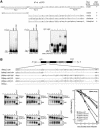
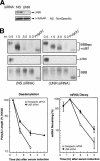
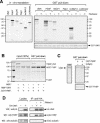

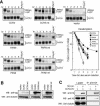
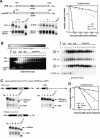
Similar articles
-
A mechanism for translationally coupled mRNA turnover: interaction between the poly(A) tail and a c-fos RNA coding determinant via a protein complex.Cell. 2000 Sep 29;103(1):29-40. doi: 10.1016/s0092-8674(00)00102-1. Cell. 2000. PMID: 11051545
-
Mammalian miRNA RISC recruits CAF1 and PABP to affect PABP-dependent deadenylation.Mol Cell. 2009 Sep 24;35(6):868-80. doi: 10.1016/j.molcel.2009.08.004. Epub 2009 Aug 27. Mol Cell. 2009. PMID: 19716330 Free PMC article.
-
PABP Cooperates with the CCR4-NOT Complex to Promote mRNA Deadenylation and Block Precocious Decay.Mol Cell. 2018 Jun 21;70(6):1081-1088.e5. doi: 10.1016/j.molcel.2018.05.009. Mol Cell. 2018. PMID: 29932901
-
Poly(A)-binding proteins: structure, domain organization, and activity regulation.Biochemistry (Mosc). 2013 Dec;78(13):1377-91. doi: 10.1134/S0006297913130014. Biochemistry (Mosc). 2013. PMID: 24490729 Review.
-
Regulation of poly(A)-binding protein through PABP-interacting proteins.Cold Spring Harb Symp Quant Biol. 2006;71:537-43. doi: 10.1101/sqb.2006.71.061. Cold Spring Harb Symp Quant Biol. 2006. PMID: 17381337 Review.
Cited by
-
RNA Binding Proteins and Regulation of mRNA Translation in Erythropoiesis.Front Physiol. 2018 Jul 24;9:910. doi: 10.3389/fphys.2018.00910. eCollection 2018. Front Physiol. 2018. PMID: 30087616 Free PMC article. Review.
-
UNR/CSDE1 Expression Is Critical to Maintain Invasive Phenotype of Colorectal Cancer through Regulation of c-MYC and Epithelial-to-Mesenchymal Transition.J Clin Med. 2019 Apr 25;8(4):560. doi: 10.3390/jcm8040560. J Clin Med. 2019. PMID: 31027221 Free PMC article.
-
Computational annotation of UTR cis-regulatory modules through Frequent Pattern Mining.BMC Bioinformatics. 2009 Jun 16;10 Suppl 6(Suppl 6):S25. doi: 10.1186/1471-2105-10-S6-S25. BMC Bioinformatics. 2009. PMID: 19534751 Free PMC article.
-
The control of elongation by the yeast Ccr4-not complex.Biochim Biophys Acta. 2013 Jan;1829(1):127-33. doi: 10.1016/j.bbagrm.2012.09.001. Epub 2012 Sep 10. Biochim Biophys Acta. 2013. PMID: 22975735 Free PMC article. Review.
-
Functional characterization of three leishmania poly(a) binding protein homologues with distinct binding properties to RNA and protein partners.Eukaryot Cell. 2010 Oct;9(10):1484-94. doi: 10.1128/EC.00148-10. Epub 2010 Jul 30. Eukaryot Cell. 2010. PMID: 20675580 Free PMC article.
References
Publication types
MeSH terms
Substances
Grants and funding
LinkOut - more resources
Full Text Sources
Molecular Biology Databases
